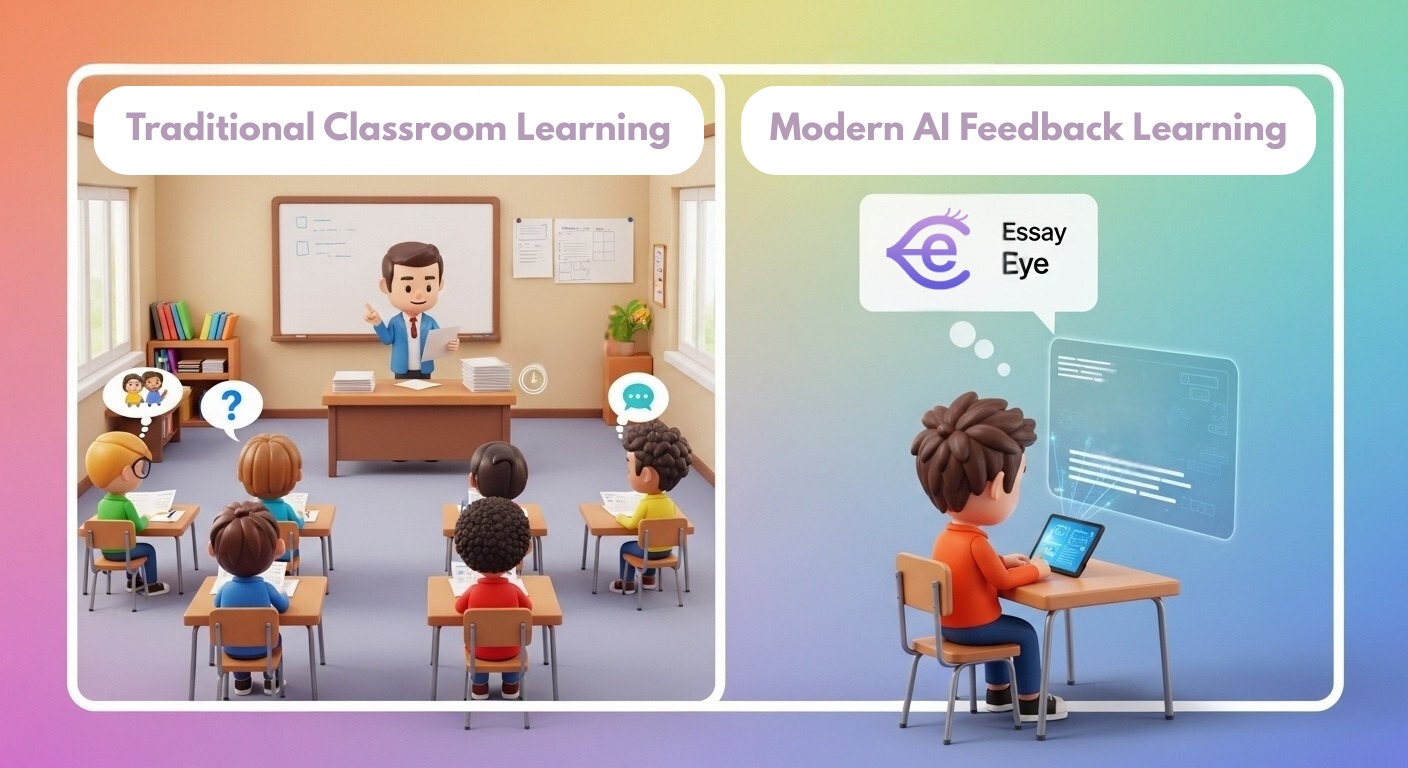In 1984, educational psychologist Benjamin Bloom introduced a startling finding that transformed how we think about student learning. Known as Bloom’s Two Sigma Problem, the research showed that students who received one-on-one tutoring performed two standard deviations—two sigmas—better than those in traditional classroom settings. In other words, the average tutored student outperformed 98% of their peers. The challenge of using college essay grader ai? Providing individualized tutoring for every student is often financially and logistically impossible in most educational systems.
That’s where Essay Eye, an AI-powered essay grading and feedback platform, enters the conversation. With real-time, detailed writing feedback, Essay Eye acts as a virtual mentor, bridging the gap between classroom instruction and the personalized attention students need to thrive. By incorporating a college essay grader AI, it offers an innovative solution to the challenge of individualized education.
What Is Bloom’s Two Sigma Problem?
Bloom’s research compared three instructional methods: conventional classroom teaching, mastery learning, and one-on-one tutoring. While mastery learning produced strong gains, it was the individualized tutoring that generated two standard deviations of improvement. Bloom then challenged educators and researchers to find scalable methods to replicate these outcomes.

The Role of Feedback in Writing Mastery
One of the central insights from Bloom’s work is that timely and targeted feedback is essential to mastery. In the writing process, students often wait days—or longer—for teachers to return essays with notes. This lag reduces the immediacy and relevance of the guidance. With Essay Eye, feedback is generated within seconds. The AI evaluates structure, evidence, clarity, grammar, and organization, then offers personalized suggestions for improvement.
This instantaneous and robust feedback mimics the responsiveness of a private tutor, allowing students to revise, reflect, and improve in real-time. By continuously engaging with this writing mentor, students deepen their metacognition, better understand expectations, and internalize the conventions of strong academic writing. Additionally, the college essay grader AI ensures that even the most complex essays are assessed with the same level of precision as those submitted by professional writers.
Essay Eye as a Scalable Writing Tutor
Unlike conventional tutoring, which is limited by time and cost, Essay Eye provides on-demand writing mentorship for every student in a classroom. This scalable solution offers:
-
Consistent feedback aligned with teacher expectations
-
24/7 availability across devices
-
Differentiated responses tailored to writing ability
-
Support for narrative, expository, and argumentative essays
In essence, Essay Eye doesn’t replace the teacher—it extends the teacher’s presence beyond the classroom and into every stage of the writing process. The college essay grader AI makes it possible for educators to focus on personalized support while the AI handles the initial assessments and suggestions.
Meeting the Needs of Today’s Students
Modern students face increasingly complex writing expectations, often without the resources needed to succeed. First-generation learners, English language learners, and students with learning differences all benefit from writing tools that provide both guidance and autonomy. Essay Eye levels the playing field by offering equity-driven, AI-powered writing support that boosts confidence and performance, powered by a sophisticated college essay grader AI that offers actionable insights for every writing project.

Closing the Gap with Technology
While Bloom’s Two Sigma Problem once seemed insurmountable, educational technology has finally caught up. Essay Eye offers a real-world, cost-effective solution to one of education’s most persistent challenges. By providing personalized feedback at scale, it moves us closer to Bloom’s vision—where every student has access to the kind of high-quality support that leads to mastery.
Why Writing Assignments Matter Across the Curriculum—Not Just in English Class
There’s a quiet assumption in many schools: writing belongs in English class. That’s where it’s taught, that’s where it’s graded, and that’s where it lives. But if we want students to truly grow—not just as test-takers, but as thinkers—then writing can’t be siloed. It must be woven into every subject, every classroom, and every discipline. Writing across the curriculum isn’t just a nice idea. It’s essential.
Let’s start with a simple truth: writing is thinking made visible. When students write in history, they’re not just regurgitating dates—they’re evaluating cause and effect, synthesizing multiple perspectives, and learning to construct arguments grounded in evidence. In science, writing forces students to go beyond memorizing formulas. It pushes them to explain processes, reflect on experiments, and engage in inquiry. Even in math, writing helps clarify reasoning—transforming abstract computations into structured problem-solving narratives.
And yet, many students only get meaningful writing assignments once or twice a year—usually in the lead-up to a standardized test or an essay contest. That’s not enough. Students need regular, low-stakes writing opportunities that help them build fluency, confidence, and stamina.

This is where Essay Eye comes in.
Our platform was never designed to replace teachers. Quite the opposite. It was built to support them—especially those outside the ELA department—by giving students instant, actionable feedback on their writing. Whether it’s a lab report, a DBQ, or a reflective journal for health class, Essay Eye gives students the kind of personalized feedback that helps them revise, rethink, and grow. The college essay grader AI ensures that students receive the same quality feedback for any subject, reinforcing the connection between writing and thinking.
The magic? It’s not just in the AI. It’s in the repetition. The regular use. The ability to make writing a natural, expected part of the learning experience—no matter the subject.
When students start to see writing as a tool for learning, not just for grading, everything changes. By slowing down, students are able to notice details more carefully. This attentiveness encourages them to question their assumptions, which in turn helps them develop a unique voice. As they continue to develop this voice, it becomes their most powerful academic asset. And that voice becomes their most powerful academic asset.
But let’s be honest: not every teacher feels comfortable assigning writing. Some worry about time. Others about grading. Still others about not having the “right” background to teach writing conventions. Essay Eye lowers that barrier. It empowers all educators—not just English teachers—to make writing part of their instruction. And it does it without piling on extra work, thanks to the college essay grader AI.
Writing across the curriculum is no longer a dream. It’s doable. It’s scalable. In a world where communication skills define opportunity, we can’t afford to treat writing as a one-subject affair.
So whether you teach biology, civics, art, or algebra, give your students a chance to write. And let Essay Eye be the partner that makes that possible—not just easier, but better.

